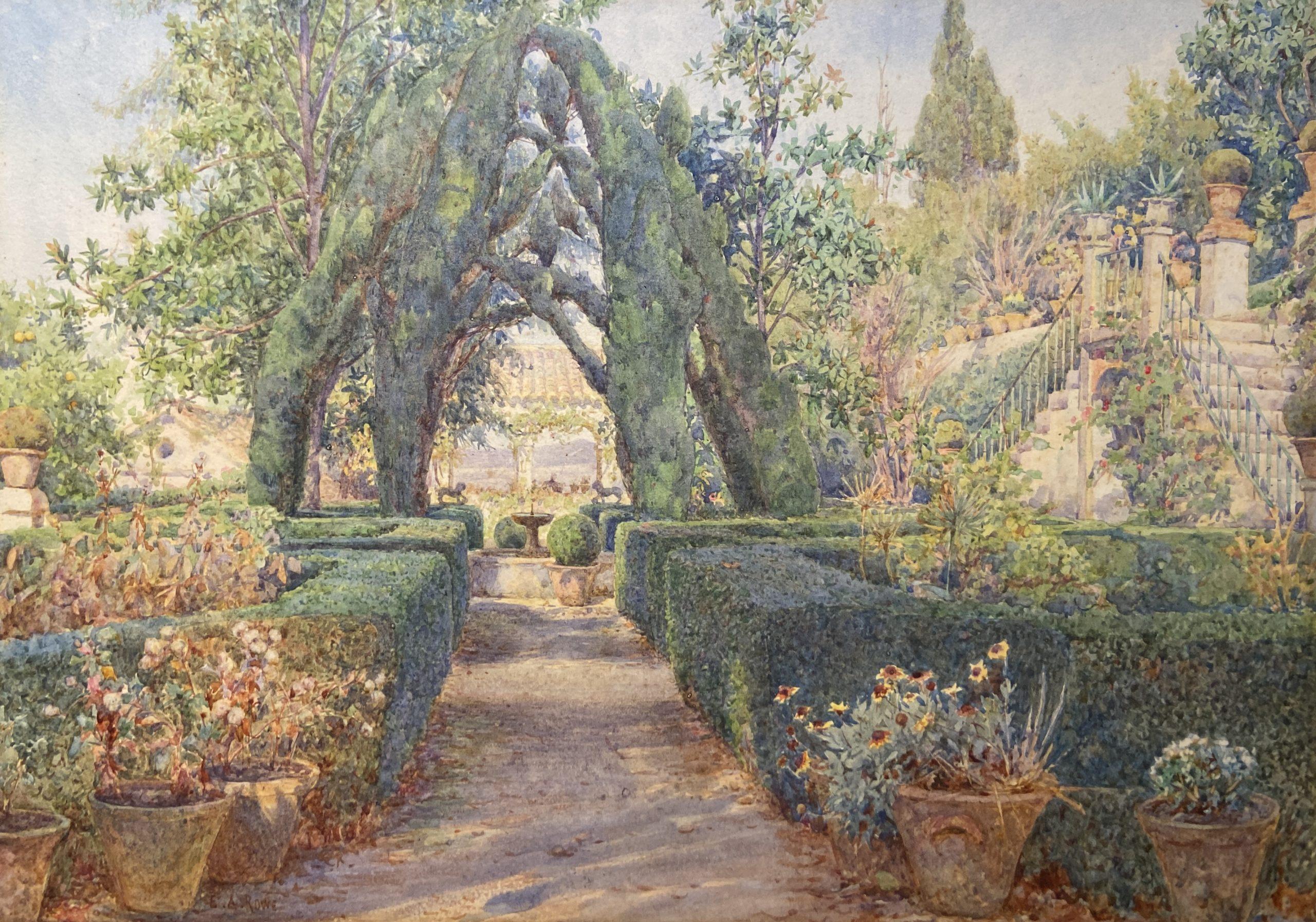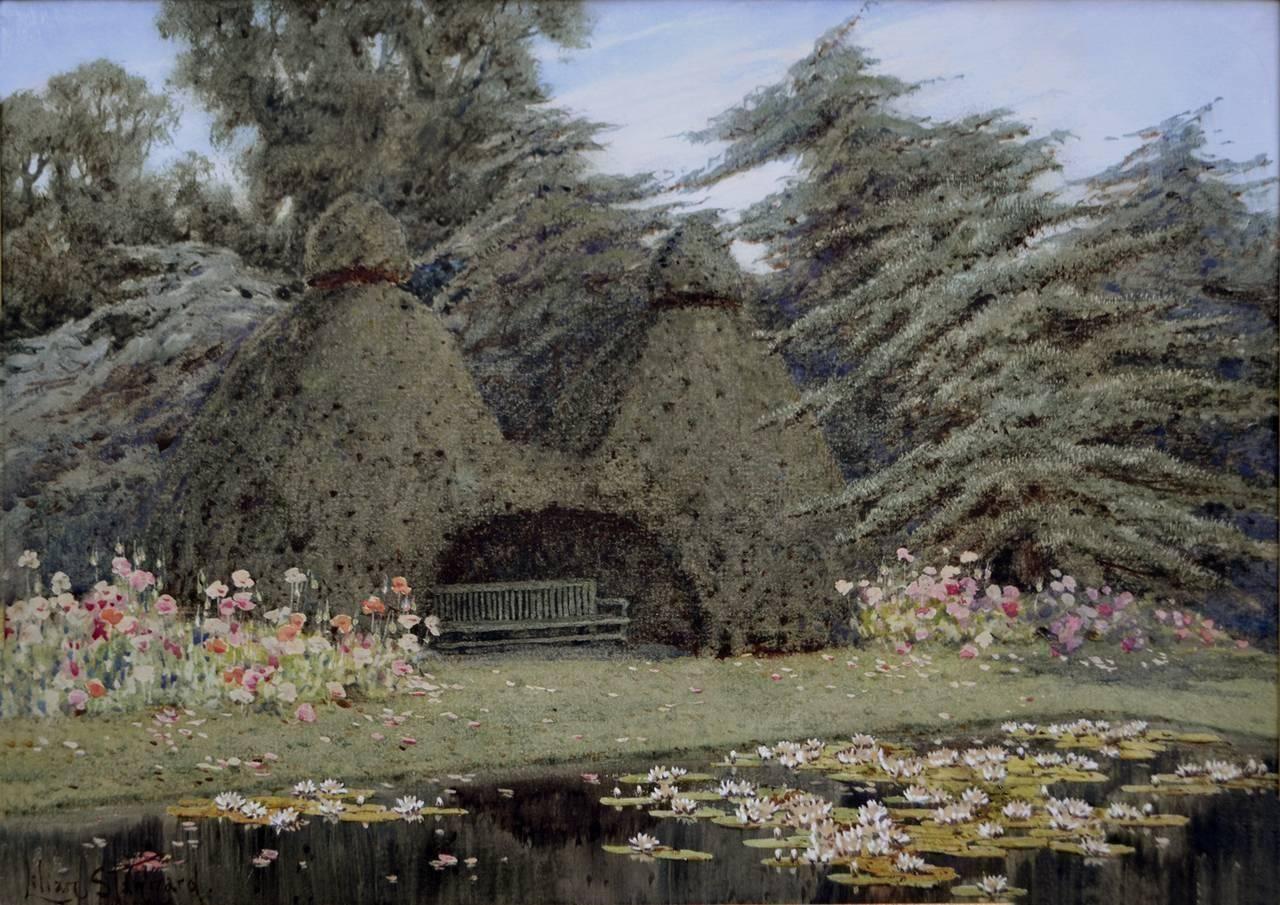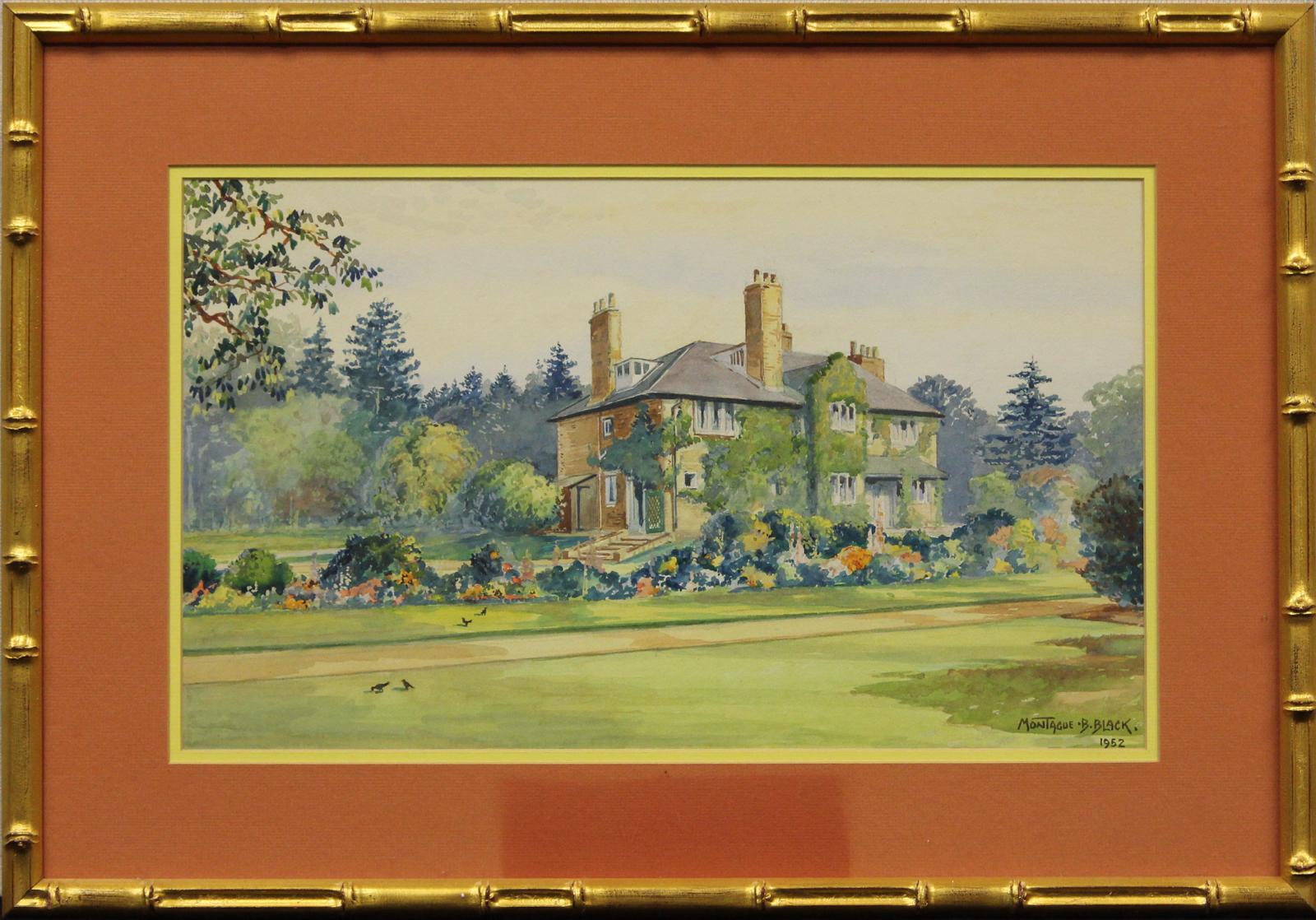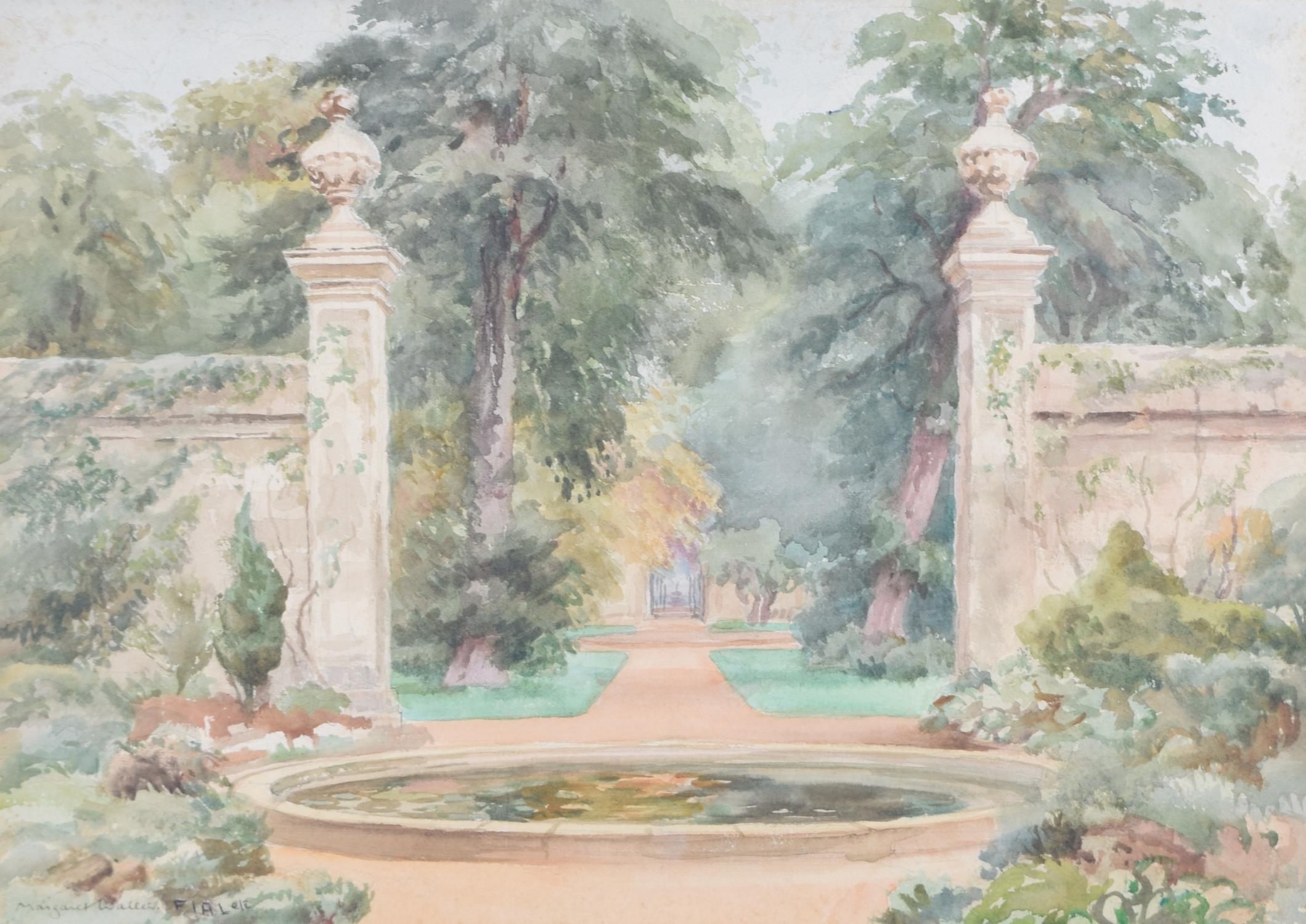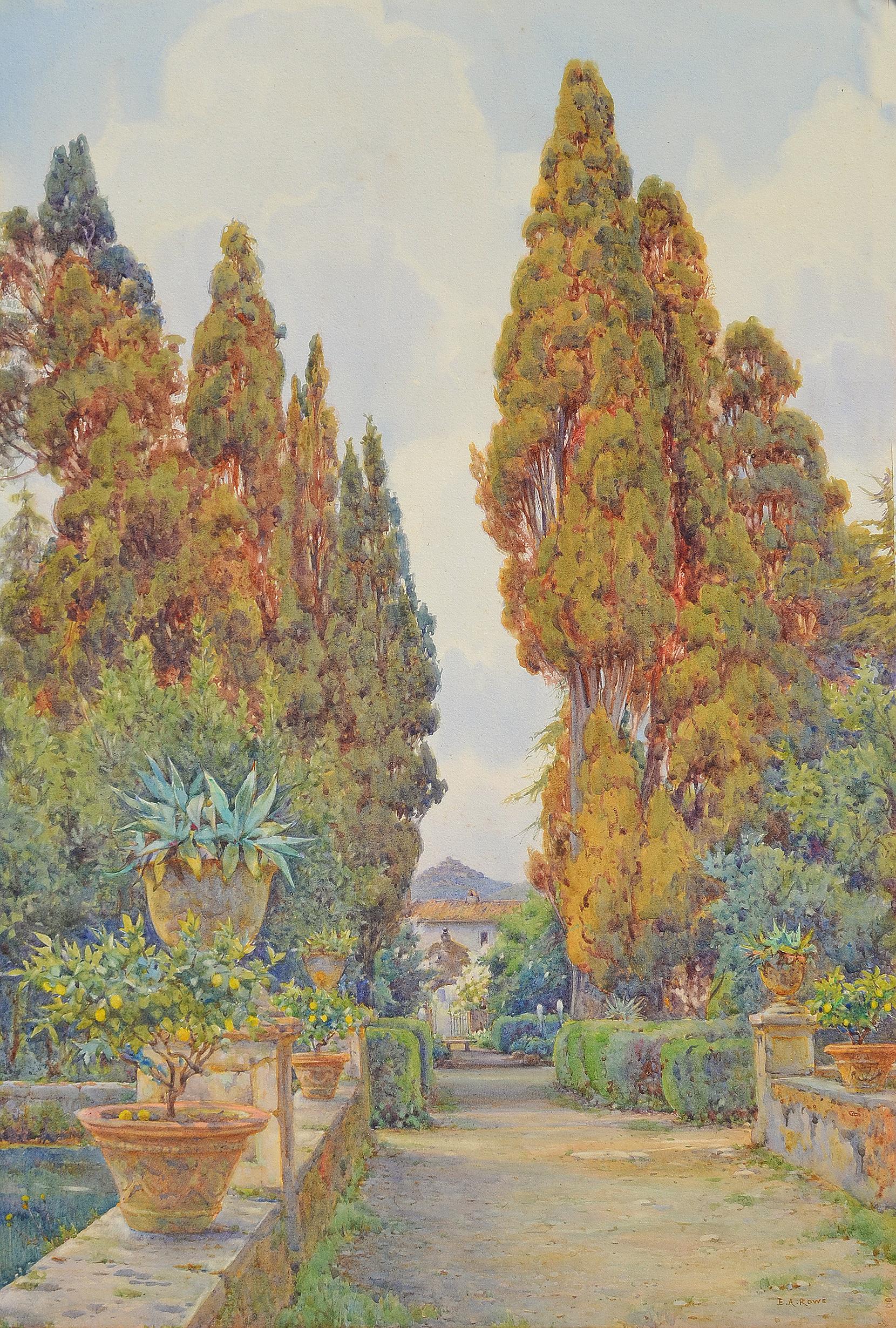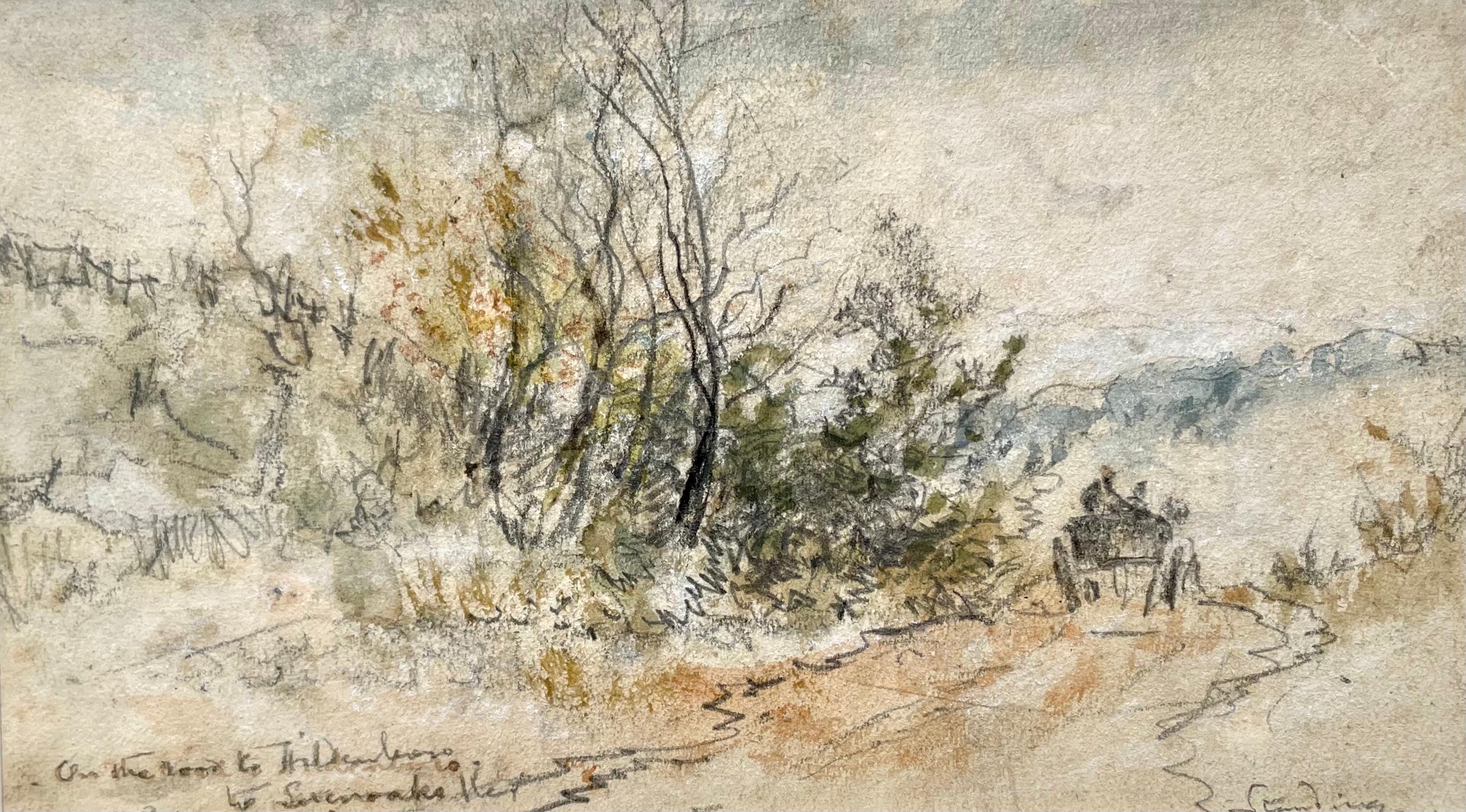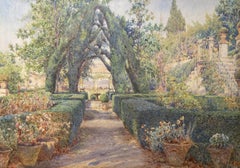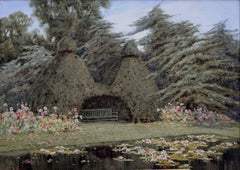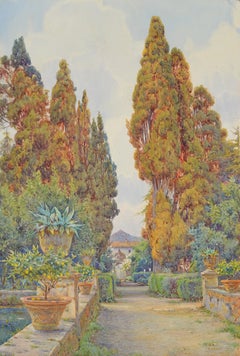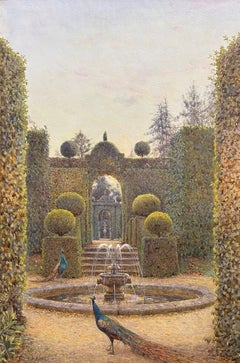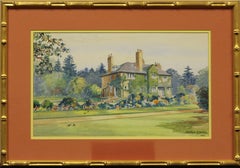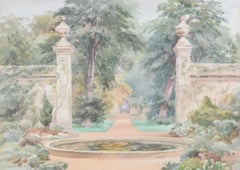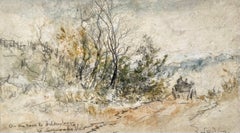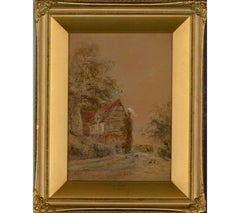Items Similar to The Hill, Hampstead, Signed Early 20th Century British Watercolour
Want more images or videos?
Request additional images or videos from the seller
1 of 5
Ernest Arthur RoweThe Hill, Hampstead, Signed Early 20th Century British Watercolour
$8,114.74
£6,000
€7,103.58
CA$11,219.34
A$12,567.54
CHF 6,600.93
MX$152,817.29
NOK 83,589.30
SEK 79,348.72
DKK 53,016.76
About the Item
Watercolour and scratching out on paper, signed lower left
Image size: 11 x 17 1/2 inches (28 x 44.5 cm)
Original giltwood frame
Provenance
Christopher Wood Gallery
R Mellon, USA
Sir William Hesketh Lever (later Lord Leverhulme) purchased Hill House in 1904. The house was extensively rebuilt and enlarged for him, after which it became known as The Hill. The gardens were laid out in three phases, each following the purchase of the three separate properties that make up the present site.
When Lever purchased Hill House, the garden was on steeply sloping ground and Mawson levelled the site into terraces, providing terrace gardens in front of the house, a level lawn, and a pergola around the west and south sides of the garden in 1906. The terraces were constructed with the spoil from the Hampstead tube excavation. The kitchen gardens were laid out between the pergola and the south-west boundary of The Hill garden. In 1911 Lord Levehulme purchased Heath Lodge (the neighbouring property to the north-west) and demolished that house. Mawson extended the pergola across a bridge over the public road that separated the two properties to a circular Garden Temple and then after a long stretch of pergola to a Belvedere at the western end, overlooking the Heath and the former Heath Lodge gardens. A conservatory on the west side of the original pergola was demolished in the process and replaced by a Pergola Temple. Service buildings were built on the eastern portion of the newly acquired land and the two-acre gardens were incorporated within the scheme.
During the First World War Leverhulme purchased Cedar Lawn (the neighbouring property to the south) and in 1922 that house was also demolished and the pergola and garden were extended to the south.
Ernest Arthur Rowe
Born on the 21st August 1862 in Stratford, East London, Rowe was the son of Thomas and Adelaide Rowe. The youngest of five, he had a brother George and three sisters Florence, Annie and Bella.
Rowe started work at sixteen as an apprentice lithographer (the making of plates used to print book illustrations etc.) from October 1878 for five years to 1883. He was dismissed from his first job as a lithographer in February 1884 and started his training as an artist at the Royal Institute of Painters on 4th February 1884, winning the President’s Medal for Landscapes in 1885.
At the age of 23 he started to paint professionally and by working a fourteen hour day he earned £90 in his first summer of work. For the next ten years he had a hand to mouth existence, earning approximately £100 per year while attending the Lambeth School of Art in the evenings. He was constantly helped financially by his mother and brother George and was always selling his paintings to friends and family. His worst year was 1890, when he only earned £30. However, in the 1890s he became interested in garden painting which proved more successful and in 1895 he sold a single painting for £68.
Unfortunately he suffered from consumption. To alleviate this he went abroad during the worst periods of the English winters. He painted in France and Spain but mostly in Italy.
In 1895 he spent some time in a sanatorium in Davos, Switzerland and there he met his future wife - Nurse Sophy Slater - the daughter of a Baptist minister from Stow-on-the Wold in Gloucestershire. By 1899 his fortune had improved enough to persuade the Reverend Slater that he was worthy, and on 6th October 1899 he married Sophy at the Baptist Chapel at Bourton-on-the-Water.
He became extremely successful. In the summers he travelled all over the British Isles painting most of the famous gardens. In the winter he painted some of the beautiful gardens and villas in Italy, Sicily, Spain and France.
During his best years his paintings were exhibited in Liverpool, Manchester, Birmingham and London including twenty-six at the Royal Academy – twenty-four at the Royal Society of British Artists and twenty-two at the Royal Institute of Painters. Every other year he held exhibitions at either the Dowdeswell or Greatorex Galleries in London. These exhibitions were attended by many famous and titled people including Queen Alexandra, Queen Mary and Princess Alice.
It is known that Queen Mary purchased at least fifteen of his paintings over several years. The present Queen exhibited four of his paintings at an exhibition "Royal Gardens of England" which was held at Sandringham in Norfolk in 1989.
In 1907 all this good fortune enabled him to build his own house at Rusthall near. Tunbridge Wells which he named "Ravello" after his favourite place in Italy. He lived there until 1915 when the First World War put an end to his travelling abroad. As so many gardeners were lost in the fighting many of the gardens became overgrown and people stopped buying paintings. In order to survive he had to sell his treasured house and he was back to hard times.
His fortune picked up again in 1920 but this was short lived because he died of consumption on the 21st January 1922. A memorial exhibition was held in London in 1925, which was attended by Queen Mary. After this he was forgotten until the 1950's when it became fashionable once again for people to hang paintings on their walls. He was also researched by Christopher Wood - once the foremost authority on Victorian garden artists.
- Creator:Ernest Arthur Rowe (1860 - 1922, British)
- Dimensions:Height: 11 in (27.94 cm)Width: 17.5 in (44.45 cm)
- More Editions & Sizes:1 of 1Price: $8,115
- Medium:
- Movement & Style:
- Period:
- Condition:
- Gallery Location:London, GB
- Reference Number:1stDibs: LU52413154372
About the Seller
5.0
Vetted Professional Seller
Every seller passes strict standards for authenticity and reliability
Established in 2007
1stDibs seller since 2014
82 sales on 1stDibs
Typical response time: 1 hour
- ShippingRetrieving quote...Shipping from: London, United Kingdom
- Return Policy
Authenticity Guarantee
In the unlikely event there’s an issue with an item’s authenticity, contact us within 1 year for a full refund. DetailsMoney-Back Guarantee
If your item is not as described, is damaged in transit, or does not arrive, contact us within 7 days for a full refund. Details24-Hour Cancellation
You have a 24-hour grace period in which to reconsider your purchase, with no questions asked.Vetted Professional Sellers
Our world-class sellers must adhere to strict standards for service and quality, maintaining the integrity of our listings.Price-Match Guarantee
If you find that a seller listed the same item for a lower price elsewhere, we’ll match it.Trusted Global Delivery
Our best-in-class carrier network provides specialized shipping options worldwide, including custom delivery.More From This Seller
View AllFlower Gardens at Generalife, Granada
By Ernest Arthur Rowe
Located in London, GB
Watercolour on paper, signed bottom left
Image size: 13 3/4 x 9 1/2 inches (35 x 24 cm)
Mounted and framed
The Generalife was a summer palace and country estate of the Nasrid rulers...
Category
Late 19th Century Victorian Landscape Drawings and Watercolors
Materials
Paper, Watercolor
The Lily Pond, English School 19th Century Watercolour Signed
By Lillian Stannard
Located in London, GB
Lillian Stannard
1877 - 1944
The Lily Pond
Watercolour, signed lower left
Image size: 9 ½ x 13 ½ inches
Contemporary gilt frame
Lillian Stannard was a celebrated painter of En...
Category
19th Century Landscape Drawings and Watercolors
Materials
Watercolor
Cypresses, Villa D'Este, Tivoli, Early 20th Century English Watercolour
By Ernest Arthur Rowe
Located in London, GB
Watercolour, signed and dated '1912' bottom right
Image size: 21 x 14 inches (53.25 x 35.5 cm)
Original frame
Exhibitions
The Fine Arts Society
Ernest Arthur Rowe
Rowe was a watercolourist specialising in garden scenes. He spent his career responding to the Victorian love of formal gardens with his meticulous paintings of the grounds of the country’s finest historic houses. Ernest Arthur Rowe was born in West Ham, which was then in Essex. He trained first as a lithographer and, in 1884, began studying at the Royal Institute of Painters in Water Colours where he won a President’s Medal in 1885.
Initially, Rowe painted landscapes in general, but by the 1890s he was specialising in gardens. During that decade, he joined the London Sketch...
Category
1910s Landscape Drawings and Watercolors
Materials
Watercolor
Brockenhurst Gardens
By Ernest Arthur Rowe
Located in London, GB
Brockenhurst Gardens
Ernest Arthur Rowe
Watercolour, signed lower left and dated 1900 bottom left
Image Size: 12 x 18 3/4 inches (46 x 30.5 cm)
Original Victorian frame
Provenance
Dowdeswell and Dowdeswell
The collection of C. Buttersworth
Sale, Bonhams, London, 10th June 1998, lot 63
Exhibited
Royal Institute of Painters in Watercolour, as 'Relics of the Civil Wars, Compton Wynyates', no.1
This watercolour is one of Rowe's few pictures of Brockenhurst park garden in the New Forest, Hampshire. Here Rowe exemplifies the garden's splendour through his deliberate low positioning within the composition. As well as the scenes mirrored...
Category
20th Century Post-War Landscape Drawings and Watercolors
Materials
Paper, Watercolor
A River Landscape, 19th Century British Watercolour, Signed and Dated 1880
By Alfred East
Located in London, GB
Watercolour on paper, signed and dated '1880' bottom left
Image size: 9 x 13 inches (23 x 30 cm)
Hand made gilt frame
Sir Alfred East
Sir Alfred East was born in Kettering, Northa...
Category
1880s Modern Landscape Drawings and Watercolors
Materials
Watercolor
St Peters Rome, 19th Century Victorian Signed Watercolour
By Ernest Arthur Rowe
Located in London, GB
ERNEST ARTHUR ROWE 1863 - 1922
St Peter's Rome
Watercolour
Signed lower left
Image size: 9 ¾ x 7 inches
Original gilt frame
Category
19th Century Victorian Landscape Drawings and Watercolors
Materials
Watercolor
You May Also Like
English Country Estate 1952 Watercolour by Montague Birrell Black (1884-1964)
Located in Bristol, CT
Delightful watercolour by the noted illustrator Montague Birrell Black (1884-1964) & dated 1952 depicting an English country house & gardens
Art Sz: 9 1/2"H x 16"W
Frame Sz: 15 1/2...
Category
1950s Landscape Drawings and Watercolors
Materials
Watercolor
University of Oxford Botanic Garden watercolour by Margaret Waller
Located in London, GB
To see our other views of Oxford and Cambridge, scroll down to "More from this Seller" and below it click on "See all from this Seller" - or send us a message if you cannot find the view you want.
Margaret Waller...
Category
20th Century Realist Landscape Drawings and Watercolors
Materials
Watercolor
Hildenborough, Sevenoaks, Kent - British Watercolour by Adolphe Ragon
Located in London, GB
ADOLPHE RAGON
(1847-1924)
On the Road from Hildenborough to Sevenoaks, Kent
Signed in pencil l.r., inscribed with title l.l.
Watercolour over traces of pencil
Unframed, in conserva...
Category
Late 19th Century Realist Landscape Drawings and Watercolors
Materials
Watercolor
E. Nevil - Late 19th Century Watercolour, Near Tring
Located in Corsham, GB
A fine and delicate watercolour painting with gouache details by E. Nevil. The scene depicts a countryside view with a farmhouse and a figure. Signed to the lower left-hand corner. A...
Category
19th Century Landscape Drawings and Watercolors
Materials
Watercolor
$383 Sale Price
20% Off
Landscape near Rye - Early 20th Cent British Watercolour by Joseph A Powell
Located in London, GB
JOSEPH ARTHUR POWELL
(1876-1961)
Oast Houses and Windmill, Rye
Signed l.l.
Watercolour
Unframed
38 by 55 cm., 15 by 21 ¾ in.
(mount size 54 by 70 cm.,...
Category
Early 20th Century Realist Landscape Drawings and Watercolors
Materials
Watercolor
W. Hinchliff - Signed Early 20th Century Watercolour, Kennington Turnpike
Located in Corsham, GB
A well executed watercolour by W. Hinchcliff, depicting the Turnpike at Kennington.The painting is signed to the lower left corner. There is an article cut-out attached to the revers...
Category
20th Century Landscape Drawings and Watercolors
Materials
Watercolor
$292 Sale Price
20% Off
More Ways To Browse
Swiss 20th Century Artists
British Landscape Paintings In Watercolors
Early 20th Century British Artists
Art Western Watercolor
William Hiller
Royal Art Lodge
Antique Western Signs
Victorian House Drawing
Used Victorian Conservatory
The Road Winter
Thomas Hill
Arthur William Best
Arthur Hill
Alice Daughter
Christopher Medals
Tunbridge Wells
Heath West
Antique Nurses
